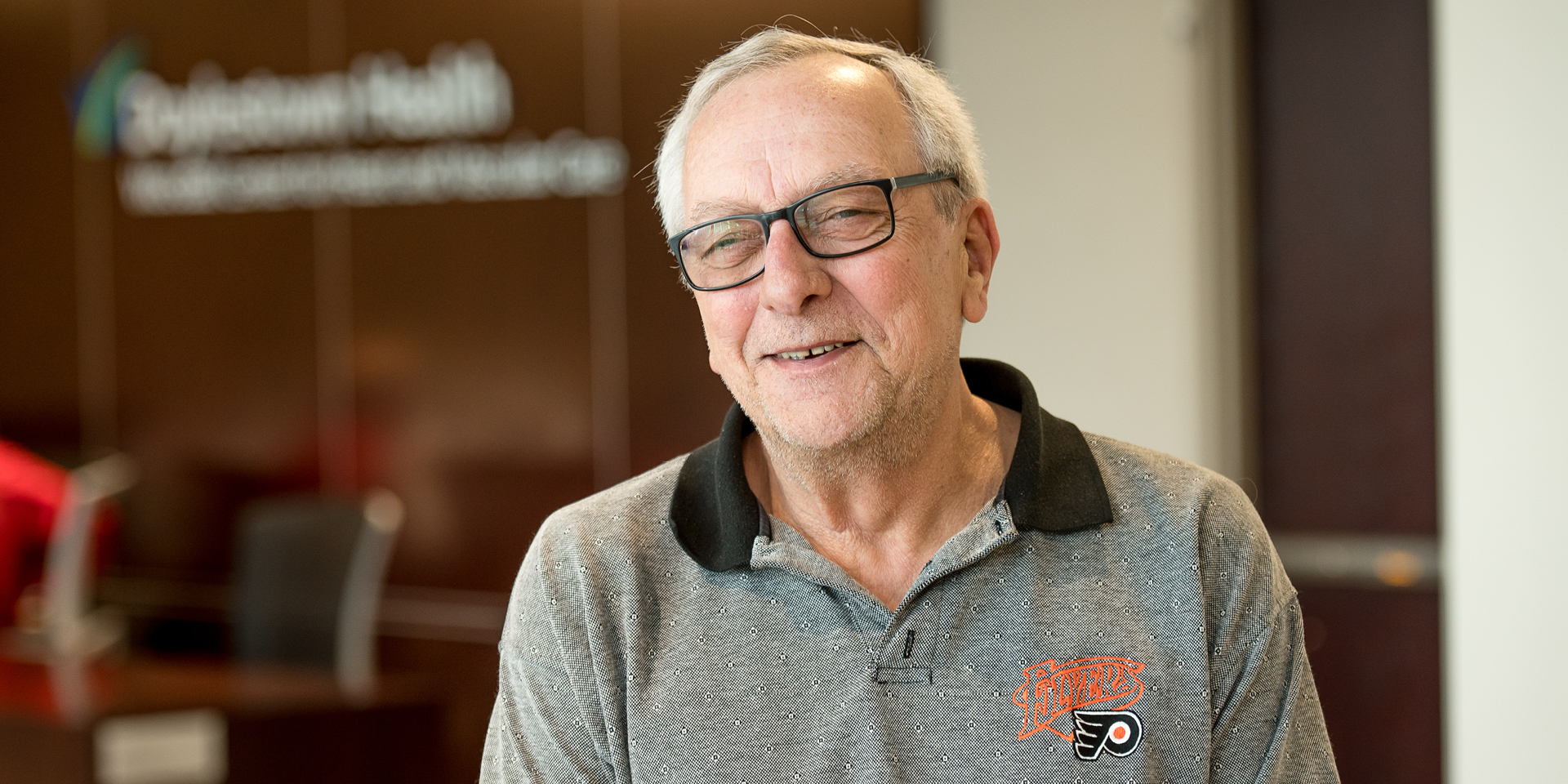Stan Gualtieri, 68, of Warrington, never really thought about hospital services, until a highly-skilled vascular surgeon and team saved his life in Doylestown Health’s state-of-the-art Endovascular Hybrid Operating Room.
Stan’s Aortic Emergency
“I first met Stan when he came to the Emergency Department (ED) with dangerously low blood pressure, abdominal pain and signs of internal bleeding,” says Doylestown Health vascular surgeon Atul Rao, MD.
He had a ruptured aneurysm in his aorta, near the iliac artery between components of a previous endovascular repair completed at another hospital.
About Aortic Disease
The aorta carries oxygenated blood from the heart to the rest of the body. A weakening and bulging of the aortic wall, called an aneurysm, expands over time and can burst (rupture), leading to life-threatening internal bleeding.
Saving Stan’s Life
“While the exact method of repair can vary based on patient factors and anatomy, the majority of aortic aneurysm treatments today are endovascular (catheter based), performed through the groin arteries,” explains Dr. Rao. “We thread a fabric-covered mechanical stent graft up through the blood vessels and reline the damaged aorta. Stan had undergone such a repair a few years prior to my meeting him; however, a component of that had failed and the artery was now ruptured and actively bleeding.”
“We emergently took Stan to the hybrid operating room to stop the bleeding by relining his failing stents,” explains Dr. Rao, who performed the procedure with his colleague vascular surgeon Joshua Eisenberg, MD.
Though Stan’s heart stopped twice, the team resuscitated him, and the procedure was a success.
“I don’t remember much from my hospital stay,” says Stan, “except that Dr. Rao saved my life. After two weeks at home, I felt strong again.”
Following Stan
“We follow patients closely,” says Dr. Rao, “Often, a genetic predisposition puts people at risk for future problems. And, while most stent grafts serve their purpose, a small portion of grafts or components can fail or migrate.”
A Growing Aneurysm
A surveillance CAT scan in the spring of 2019 revealed a problem. The new stent was secure, but an area next to it was bulging and about to rupture. At this point, Dr. Rao suggested an open vascular procedure. He and Dr. Eisenberg would remove the stents and replace the weak section of Stan’s aorta with a strong, artificial tube.
“Though the surgery was challenging because of extensive scar tissue, Stan recovered beautifully and left the hospital in great shape,” says Dr. Rao.
Another Emergency
Several months later, Dr. Rao was called to the ED in the middle of the night. Stan had arrived with chest and back pain, and suddenly, couldn’t move or feel his legs.
Even though his aorta looked good in a recent CAT scan, Stan now had a large tear in the inner lining of a different portion of the aorta – an area that had never been treated and had never had a problem, based on prior imaging.
This tear caused a separation (called an aortic dissection) between the layers of his aortic wall, resulting in blood flowing through two channels now, and the “false channel” was actually compressing the “true channel,” limiting blood flow to certain organs including Stan’s legs, which were pale and pulseless. “Stan was at significant risk of losing both legs if blood flow could not be restored within four to six hours,” says Dr. Rao.
IVUS to the Rescue
“This situation underscores the importance of the Endovascular Hybrid Operating Room,” says Dr. Rao, “Our intra-vascular ultrasound (IVUS) is especially important in imaging blood vessel tears.”
The IVUS, a tiny ultrasound sensor on a catheter, provides real-time images from inside blood vessels. Using IVUS, Dr. Rao performed a catheter-based procedure known as Thoracic Endovascular Aortic Repair (TEVAR), to reline and seal the torn aorta, restoring blood flow and saving Stan’s legs.
Back in the Game
A sports fan, Stan is happily watching and cheering for his favorite Philadelphia teams, walking his dog for exercise and enjoying every moment with his wife, children and grandchildren.
“I’m grateful to have high-level vascular services right up the road,” says Stan, who shares a special bond with Dr. Rao, who performed a series of complex procedures to repair Stan’s aorta. “I love the guy, and my wife feels the same way.”
Doylestown Health’s Aortic Center
Coordinated Care for Better Outcomes
Doylestown Health's Aortic Center delivers a personalized approach and highly coordinated care with advanced expertise, innovative treatment options and state-of-the-art facilities.
Our heart and vascular experts provide screening, diagnosis and management for all types of aortic disease. Our multidisciplinary providers collaborate to identify and deliver the best treatment options for each patient, and an outstanding care experience.
Learn more: visit DoylestownHealth.org/Vascular or call 215.230.6982
About Vascular Surgery
Doylestown Health vascular surgeons offer advanced diagnosis and treatment of an array of vascular conditions. Vascular services include comprehensive diagnostic and therapeutic interventions for conditions of the arterial and venous systems. Doylestown Health’s highly experienced, fellowship-trained endovascular surgeons perform complex open surgeries and minimally-invasive endovascular treatments in Doylestown Hospital’s sophisticated hybrid operating room.
